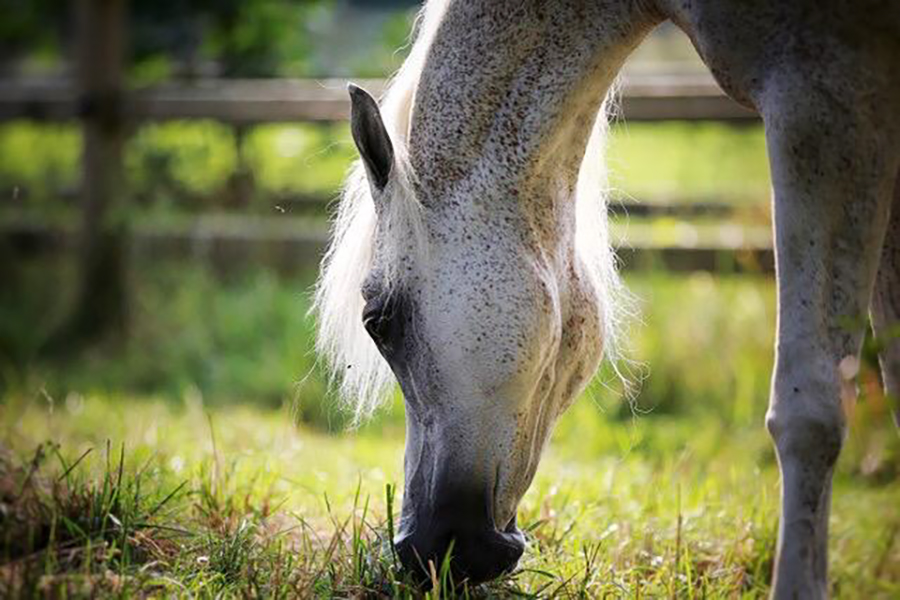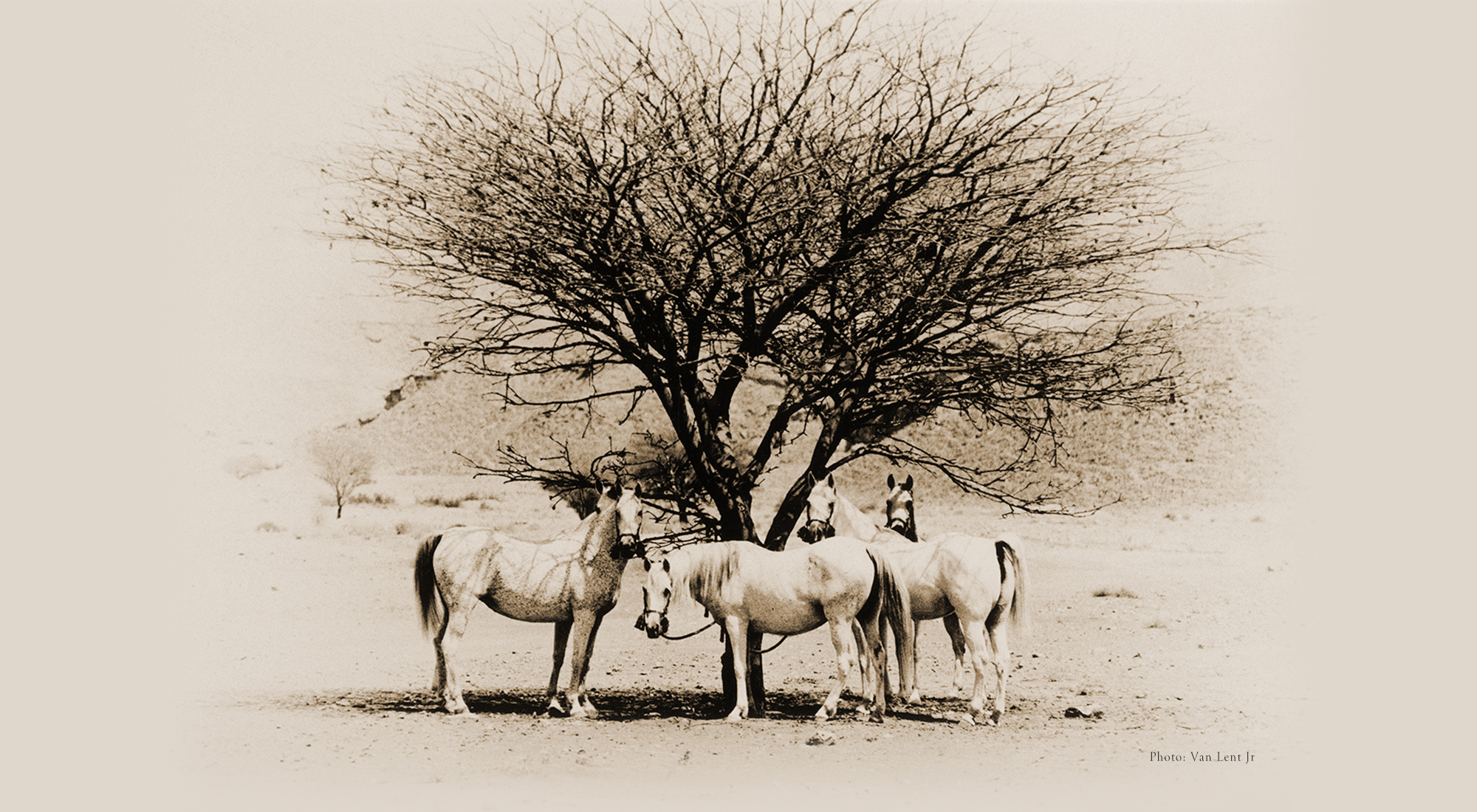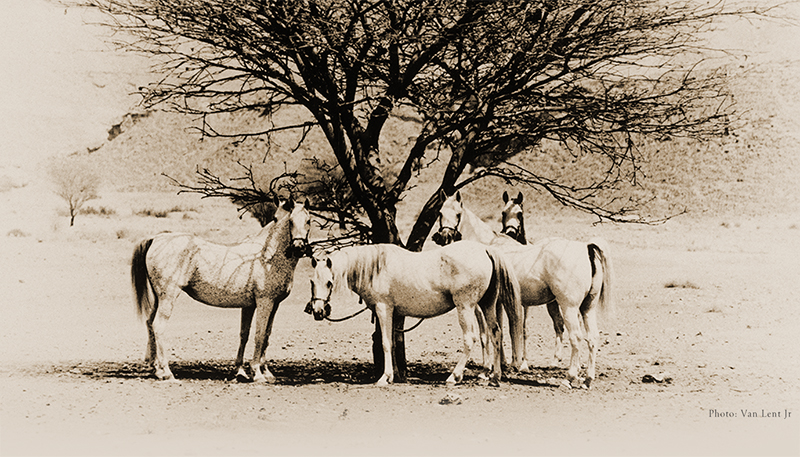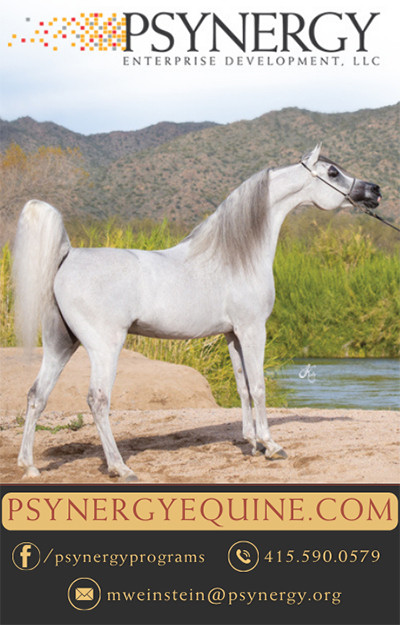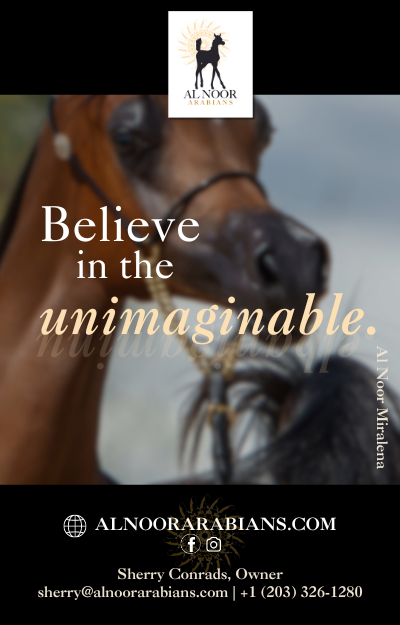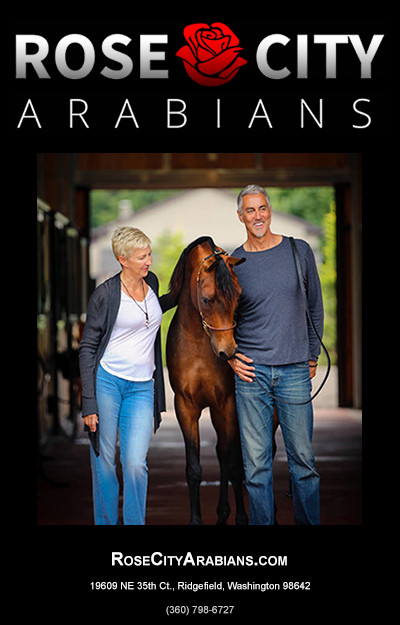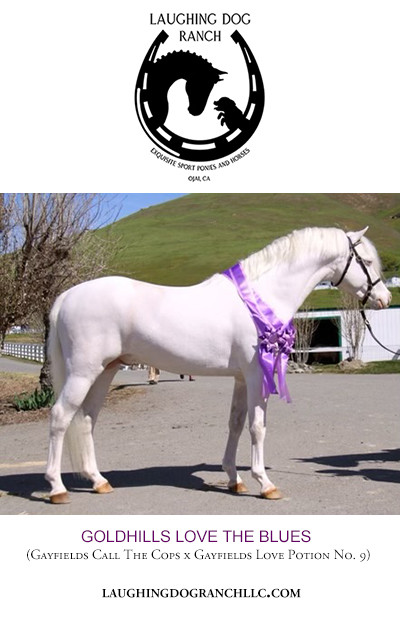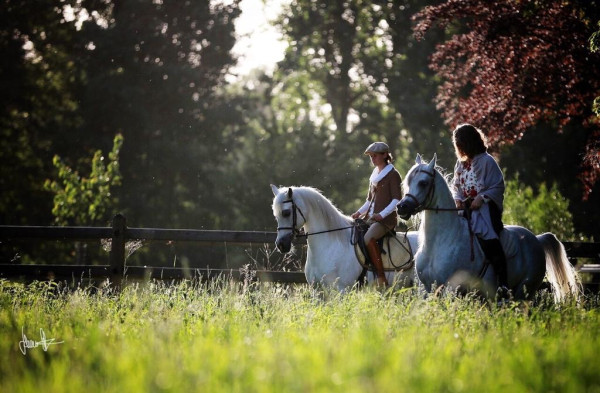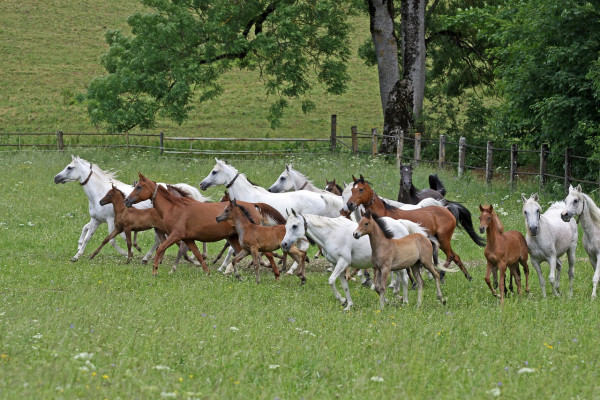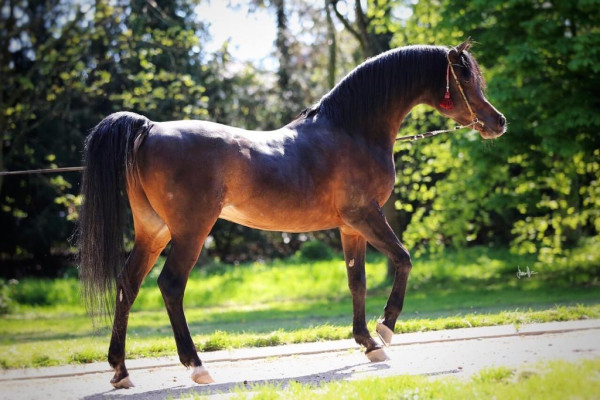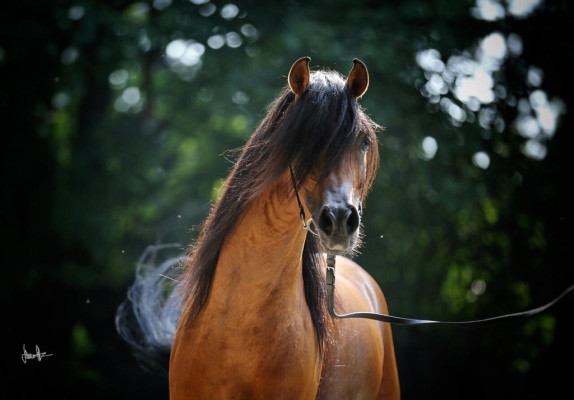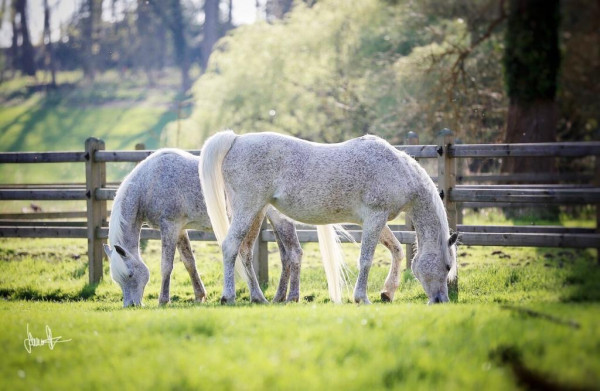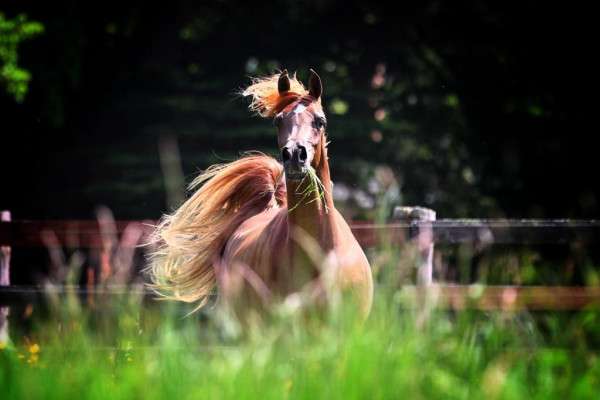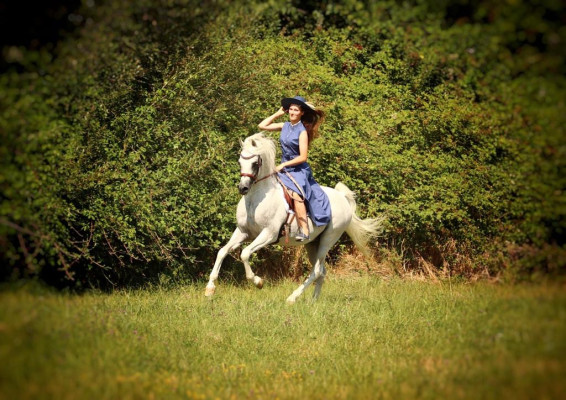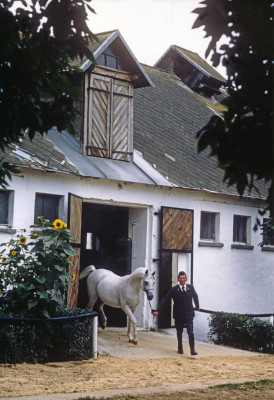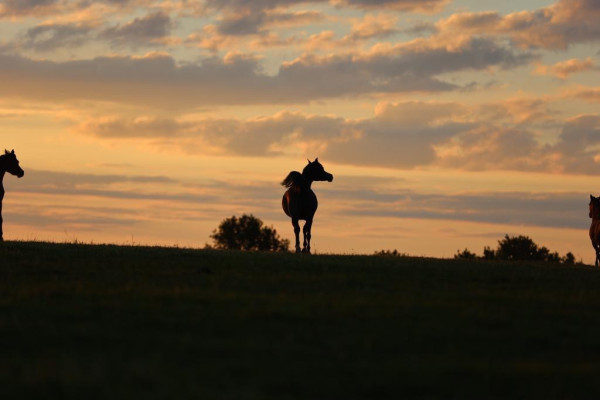In Consideration of the Arabian Horse, Part 1
by Rob Bick
If we want people to come into our breed, we have to breed horses that people want. I think we breed beautiful horses, and athletic horses and good-minded horses but we allow people to spread the notion that Arabians are crazy and expensive. And we don’t do enough to show people that that is not true. Part of it is true. We do have some crazy ones that are expensive. But every other breed has them too. We don’t have to allow that. We can push back a bit.
 Rob Bick has a soft spot for the mare May Dancer V (Sundance Kid V x Magdalena V), now 26 years old. “She made an impression on the breed, and changed the look of the Arabian western horse,” he says. "She is a special and sweet mare who I was honored to ride to 2004 U.S. National Champion Western Pleasure Futurity." May Dancer is now 26 years old, and is pictured with Rob at her home at Dolorosa Arabians.
Rob Bick has a soft spot for the mare May Dancer V (Sundance Kid V x Magdalena V), now 26 years old. “She made an impression on the breed, and changed the look of the Arabian western horse,” he says. "She is a special and sweet mare who I was honored to ride to 2004 U.S. National Champion Western Pleasure Futurity." May Dancer is now 26 years old, and is pictured with Rob at her home at Dolorosa Arabians.
The Keystone event in Florida showed people who were not familiar with our horses, some really nice horses and what disciplines they were capable of doing, and how personable they are. I think that’s huge in terms of getting our numbers up. There’s a lot of turmoil in our breed right now, from AHA on down. I don’t think that AHA can take the credit or the blame for the state of the breed. They were not set up to be a promotional organization; they are more about record keeping and horse shows, which fund their record keeping.
If everyone who owns an Arabian horse would promote the breed to their friends, and show what these horses can do, that will have more of an impact than anything AHA can do. If everyone who owns an Arabian brings one friend into the breed we could double our numbers in a year.
"It all starts with breeding a horse that people want."
Are we turning people away by our attitudes or activities or are we drawing them in?
It all starts with breeding a horse that people want. What IS the function of this horse? Does it have to be a riding horse? There are a lot of people who love horses who don’t want to ride. But we do have to breed functional horses, whatever the activity. Whether it’s a western or an English horse, it needs to be mentally and physically built to do that job, in order for the owner and the horse to be happy.
There is nothing more frustrating than having a horse that you thought was going to perform the discipline that you wanted to do, and you’re forcing this horse to do it. The truth is the horse is just not built to do it. A horse that is physically capable appears to be really smart. I don’t think there are dumb horses out there, rather, there are horses that are incapable of performing in certain disciplines. He physically can’t do it, so he seems dumb.
When horses are physically capable they seem a whole lot smarter. For a horse like PA Kid Khan (Sundance Kid V x Kharrea PGA by *Khadraj NA) to wear the western bridle, he seems so smart. All you do is get on him and click him forward and his neck drops into that crazy cool position, and that’s just where he goes. Of course he seems smart. He doesn’t have to do anything that he can’t do all day long.
Sheila Varian used to say that her farm was set up so that every horse could have a good day. And this ties into “form to function.” If you are trying to cram a flat-necked horse into a round frame, he’s not going to have a very good day. Part of that horse having a good day is doing something that he is built to do, physically and mentally.
“A champion is a champion, and they can do it anyway they want.”
Having a good day can also be affected by how a horse lives and what he or she is doing in their life. I had a mare this week that was messing around in her stall, and pacing, just not comfortable. I moved her across the aisle where the view out her door is a different side of the farm, and she loves it over there. It’s only 30 feet away, but those are things that are worth paying attention to with horses, because if we don’t they could have illness issues, get dehydrated or colic, because they are not settled in their life, or where they live. The mare has been in the new stall for about a week and she has really settled down, and has a different look in her eye, as if to say, “OK I like it here.”
A training barn often has several stallions, and will juggle where they’re each going to live. And stallions are territorial. You can put all the stallions in one wing of the barn and they will be great. You add one mare to that mix and they’re all not great. They’re going to fight over her. Or you can put each one in a different corner of the farm where they each have their little group of horses that they are looking over, and they’re fine that way.
There are different ways to manage those horses. You have to pay attention to your horse and his behavior and activity, to recognize if there is something bothering the horse. Can it be a simple change? What is it that he needs? Ulcers are common with horses nowadays. And it’s not just horses in stalls. At times there are problems with horses that are out in pastures. One thing that helps is to put horses out in even numbers – 2, 4, 6, 8…that way there is no odd man out. I’ve seen it with three mares in the pasture, and the one that is the odd one out ends up not fitting in, getting sick or losing weight, or getting kicked away from the feed, so they’re always unsettled.
Sometimes it takes a little time to recognize how that horse is living out there. You might not notice that that horse is by itself all the time. We don’t always look to see how the horses are living out there. They can develop ulcers because they don’t have a friend. Just being able to eat consistently and have food in their stomach will solve the problem. If they are bored, they might go off and start cribbing. Using a slow feed hay bag, where they have to pick at their food and keep busy, will slow their cribbing way down.
“Horses sense and feel a whole lot more than we give them credit for.”
Another odd thing that you see with horses sometimes: the strangest things are hereditary. We’ve had horses that are bad haulers, and they might be by or out of a horse that’s a bad hauler, and it might be out of a recipient mare. And it still acts like its sire or dam.
Here at the farm, we have a family of horses that yank out of the halter and take off. This is a four-generation issue. And the more we pay attention to it and tryto fix it, the more amplified it gets. The great-grandmother does it, the grandmother does it, the mother does it and the one-month-old baby is trying to do it. We act like our parents. They are expressing their desire to be a little bit above you in the pecking order. Now THAT is posturing. She’s saying, in this game right here, “I am the Queen. I’m free, bye! For now!” It’s not that they are hard to catch, but when they are walking out to pasture they just want to be free right now!
And they might not have any other issues; they have this one thing. “This is my thing that I do.”
 “I enjoy helping people with their horses," says Rob, pictured here with Kristin Girard and Chellone LF (Montechello V x Vanessa EA) at Region Five this year, where the pair won Champion Western Pleasure AAOTR.
“I enjoy helping people with their horses," says Rob, pictured here with Kristin Girard and Chellone LF (Montechello V x Vanessa EA) at Region Five this year, where the pair won Champion Western Pleasure AAOTR.
We act like our parents. This knowledge might encourage people to pay more attention to pedigrees and associated behaviors when they go to buy horses. We go see the behavior of the dog before we get a puppy. It’s the same with horses. You add it all up and it’s pretty clear. They will mostly fall into line with who their parents were. Right down to when they go to a horse show and get all upset, wash out.
We want to raise horses that are comfortable when traveling, and when they are stabled. We’ve had horses that got to shows and had to live in earplugs 24/7 at the show. We found that these were the bigger shows with more “atmosphere.” These horses were fine at the little class A shows, but at a 1,000-horse show with the vibe in the air, the horse would respond to that. It’s overwhelming for them.
Horses sense and feel a whole lot more than we give them credit for.
Getting them into a routine can be helpful. For instance, if we are going to travel, what do we have to do with the routine to make it a successful voyage? We like to have bars between the stalls so they can see each other, talk to each other and touch each other. But when you get to the horse show and it’s a solid wall,now he’s trying to stand on his hind legs, look over the wall, and he’s sweating up. He can’t see his friends. So I have to anticipate...he needs to be weaned from the other horses so he can travel solo and not loose 25 or 30 pounds or get sick or colic.
At the farm we have some stalls that are solid and some that aren’t. Same with Scottsdale. So I can rotate them just so that they don’t get so attached to one friend and get upset when you take him away. If at all possible we try to haul horses that are familiar with each other.
"Sheila Varian used to say that her farm was set up so that every horse could have a good day."
People have a lot of opinions about hauling horses. I like to keep them on the same feeding schedule that they’re on at home, as far as what time and what they eat. Some people don’t grain them on a trip. I like to keep them on the same feed they eat when they’re at home. Ideally I like to stop when they are eating and let them have a break. Likewise I have my meals at the same times as the horses
If you can’t layover, just stopping the trailer and letting them rest in the trailer will help them a lot. I lengthen their ties so they can get their heads down below their chests, clear their lungs and help prevent shipping fever. Make sure the horses are drinking enough water. Sometimes they’re just too uptight to think about water. And sometimes we don’t stop long enough to let them settle and drink. If you can hang the water bucket in there with them that’s helpful. We’ve had horses that were high-headed, high-strung, and we plan accordingly – give him more space in the trailer so that his head can be completely free or make more stops so he can come out of the trailer.
It’s important to be taking temperatures on your horse when you haul them. Often, they will look bright, but they’ll have a 103 degree temperature and you don’t recognize it until you’re a day or two late. They need help quicker than that.
I felt like any time we went over 24 hours we were looking at trouble. A 12-hour day is great. And then a layover. If you are only going to lay over for four to five hours that horse never settles down. You might as well just park the trailer for three to four hours.
And the other thing is where are you laying over? Is it horse friendly? Do they have stalls that are big enough? Did you put enough bedding in the stall? A lot of people don’t bed their trailers deep enough, and horses don’t want to pee in the trailer when they might get splattered. That’s one of my pet peeves – that’s not the place to short sheet your horse.
Murrell Lacey was a great horseman, with whom I worked for sometime. He was really good at getting into horses’ heads. One of his big things was teaching them to tie properly while tied to a wall, and accept moving away from pressure, side to side and back-and-forth.
We had a big strong, mare there called SX Geniis Pride (*Serafix x Indian Genii). She was the best mare on the farm. She was also a U.S. National Reserve Champion Mare and an English Pleasure Champion. And when we got to her, Murrell said, “Oh no, don’t tie her up!”
They just didn’t tie that mare because she would pull the damn barn down. And here’s the tip: You have to be willing to be flexible at any point when a horse just flat doesn’t want to something. Let’s find a way where she will do it, and she likes it.
Here’s a funny thing Sheila Varian said that seems apropos: “A champion is a champion, and they can do it any way they want.”
